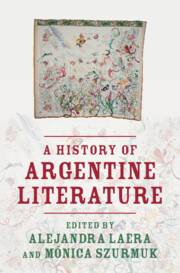Book contents
- A History of Argentine Literature
- A History of Argentine Literature
- Copyright page
- Contents
- Figures
- Contributors
- Editors’ Acknowledgments
- Introduction
- Part I Literary Dates
- Part II Critical Inroads
- Part III Literary Names
- Chapter 21 Sarmiento: Politics, Culture, and Spectacle
- Chapter 22 The Mansilla Siblings: A Story in Syntony
- Chapter 23 Martín Fierro: Subaltern Voices
- Chapter 24 Borges and Argentine Literature: A Detour around the World
- Chapter 25 Roberto Arlt
- Chapter 26 The Ocampo Sisters
- Chapter 27 Alfonsina Storni and Alejandra Pizarnik
- Chapter 28 Displacement and Transfer in Julio Cortázar’s Todos los fuegos el fuego
- Chapter 29 Manuel Puig’s Circuit Bending: Literary Listening against Surveillance
- Chapter 30 Operation Massacre: Dangerous Journalism
- Chapter 31 The Politics of the Poem: From Gelman to Perlongher
- Chapter 32 Scenes from Postmodern Life: Literary Interventions in the Public Sphere
- Chapter 33 Griselda Gambaro and Beyond: A “Dermography” of Contemporary Women’s Theater and Performance
- Chapter 34 César Aira and the Art of Invention
- Index
- References
Chapter 29 - Manuel Puig’s Circuit Bending: Literary Listening against Surveillance
from Part III - Literary Names
Published online by Cambridge University Press: 09 May 2024
- A History of Argentine Literature
- A History of Argentine Literature
- Copyright page
- Contents
- Figures
- Contributors
- Editors’ Acknowledgments
- Introduction
- Part I Literary Dates
- Part II Critical Inroads
- Part III Literary Names
- Chapter 21 Sarmiento: Politics, Culture, and Spectacle
- Chapter 22 The Mansilla Siblings: A Story in Syntony
- Chapter 23 Martín Fierro: Subaltern Voices
- Chapter 24 Borges and Argentine Literature: A Detour around the World
- Chapter 25 Roberto Arlt
- Chapter 26 The Ocampo Sisters
- Chapter 27 Alfonsina Storni and Alejandra Pizarnik
- Chapter 28 Displacement and Transfer in Julio Cortázar’s Todos los fuegos el fuego
- Chapter 29 Manuel Puig’s Circuit Bending: Literary Listening against Surveillance
- Chapter 30 Operation Massacre: Dangerous Journalism
- Chapter 31 The Politics of the Poem: From Gelman to Perlongher
- Chapter 32 Scenes from Postmodern Life: Literary Interventions in the Public Sphere
- Chapter 33 Griselda Gambaro and Beyond: A “Dermography” of Contemporary Women’s Theater and Performance
- Chapter 34 César Aira and the Art of Invention
- Index
- References
Summary
Scholars have long understood Manuel Puig’s work as embedded in media history, as he reinvented the novel by adapting techniques from film, radio-novelas, and soap operas. Critics like Alan Pauls linked gossip to the media circuitry of Puig’s first novel, while Josefina Ludmer wrote of how radio-novelas pertain to the “justice of the kitchen knife” in Boquitas Pintadas, and Francine Masiello discussed the relationship between invertido and inversión that Puig plots in entangling sexuality, media, and neoliberal capital. This chapter deepens Puig’s media history with special attention to sound across Puig’s novels, but with a particular focus on El beso de la mujer araña (1976). That novel has been hailed for its cinematic flair, but critics have tended to ignore the importance of listening in the book: from Puig’s own tape-recorded interviews in preparing the manuscript to Molina’s listening as an agent of the state to the shared listening that brings the characters together. Drawing from work on “aurality” by Ana María Ochoa Gautier, Jonathan Sterne, and others, this chapter explains and analyzes how listening became Puig’s queer response to authoritarian power and the media technologies of his day.
- Type
- Chapter
- Information
- A History of Argentine Literature , pp. 451 - 471Publisher: Cambridge University PressPrint publication year: 2024



